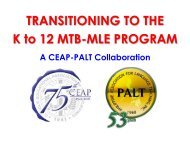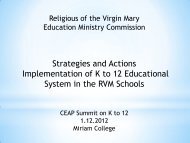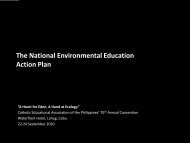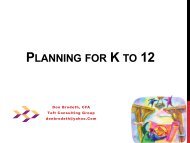PREDICTIVE MODEL OF TOTAL QUALITY MANAGEMENT (TQM ...
PREDICTIVE MODEL OF TOTAL QUALITY MANAGEMENT (TQM ...
PREDICTIVE MODEL OF TOTAL QUALITY MANAGEMENT (TQM ...
You also want an ePaper? Increase the reach of your titles
YUMPU automatically turns print PDFs into web optimized ePapers that Google loves.
<strong>PREDICTIVE</strong> <strong>MODEL</strong> <strong>OF</strong> <strong>TOTAL</strong><br />
<strong>QUALITY</strong> <strong>MANAGEMENT</strong> (<strong>TQM</strong>) FOR<br />
EDUCATION INSTITUTIONS<br />
ALFREDO MOSENDE DIMAANO<br />
Dean of the Graduate School<br />
St. Paul University Philippines<br />
Tuguegarao City, Cagayan
RATIONALE:<br />
Education has to be about<br />
quality and excellence. And<br />
educational institutions are<br />
business enterprises. The<br />
quality and excellence that the<br />
educational institutions,<br />
particularly higher education<br />
institutions, aim to achieve is<br />
a transformed way of being in<br />
the world – not just…
accumulation<br />
of facts<br />
at par<br />
Skills Technology<br />
knowledge
It is rather the quality of<br />
presence they share with<br />
their students, teachers,<br />
and stakeholders; and<br />
the quality of<br />
relationships they shared<br />
with each other-systems<br />
and subsystems,<br />
strategies, procedures,<br />
attitudes, and beliefs.
In the beginning of the<br />
21st century, most<br />
institutions of higher<br />
education in the world are<br />
facing the same challenges:<br />
greater demand for<br />
enrollment, a diverse<br />
student body, the impact of<br />
globalization and<br />
expanding technological<br />
demands.
How can<br />
institutions of<br />
learning increase<br />
their overall<br />
capacity to meet<br />
the various<br />
challenges in this<br />
new millennium?
The Philippine<br />
higher education<br />
system has<br />
considerable<br />
capacity in<br />
research,<br />
teaching, physical<br />
and human<br />
resources.
Yet the system is fundamentally<br />
flawed by inequities,<br />
imbalances and distortions<br />
deriving from its history and<br />
present structure.
Higher education<br />
can play a pivotal<br />
role in the political,<br />
economic and<br />
cultural<br />
reconstruction and<br />
development of<br />
Philippines.
For it to do so, the<br />
strengths in the system<br />
must be maintained; but<br />
the weaknesses must be<br />
remedied. To preserve<br />
what is valuable and to<br />
address what is defective<br />
requires transformation.
The system of higher<br />
education must be<br />
reshaped to serve a<br />
new social order, to<br />
meet the pressing<br />
national needs, and to<br />
respond to a context<br />
of new realities and<br />
opportunities.
The study of comparative<br />
education has provided<br />
an idea that Philippines<br />
needs schooling that<br />
envisages a new system of<br />
higher education<br />
characterized by<br />
increased participation<br />
by all sectors of society;
y greater institutional<br />
responsiveness to policy<br />
imperatives, and by a<br />
new set of co-operative<br />
relations and<br />
partnerships between<br />
higher education and<br />
the broader society.
Colleges and<br />
universities today,,<br />
are being held to<br />
increasingly higher<br />
standards by the<br />
many groups to<br />
which they provide<br />
programs and<br />
services.
To meet these rising<br />
expectations, higher<br />
education has been<br />
challenged to continue<br />
to improve the quality<br />
of academics and the<br />
full array of co-<br />
curricular and support<br />
services.
The pursuit of the principle of<br />
quality means maintaining<br />
and applying academic and<br />
educational standards, both<br />
in the sense of specific<br />
expectations and<br />
requirements that should be<br />
complied with and in the<br />
sense of ideals of excellence<br />
that should be aimed at.
The definition of these<br />
expectations and ideals can<br />
differ from context to<br />
context, partly depending on<br />
the specific purposes<br />
pursued. Applying the<br />
principle of quality entails<br />
evaluating services and<br />
products against set<br />
standards, with an end view<br />
towards improvement,<br />
renewal or progress.
To précis the aforementioned<br />
precepts, it can be surmised<br />
that because quality is<br />
process dependent and the<br />
success of one process is<br />
dependent on how well all the<br />
processes are working, it is<br />
more effective to judge<br />
quality through a systematic<br />
assessment of the entire<br />
organization.
Thus, this study was<br />
conceived and directed to<br />
ascertain the level of total<br />
quality management of the<br />
higher education<br />
institutions, particularly in<br />
Surigao City, geared<br />
towards the development<br />
of a predictive model of<br />
Total Quality Management<br />
(<strong>TQM</strong>).
This research<br />
therefore is expected<br />
to serve as an impetus<br />
to provide evidence<br />
that quality and<br />
excellent education<br />
happens in an<br />
organization with high<br />
level total quality<br />
management index.
• sex<br />
• age<br />
Profile of the<br />
Participants<br />
• civil status<br />
• length of service;<br />
• employment status<br />
• highest education<br />
attainment<br />
• type of HEI<br />
currently employed<br />
• present<br />
employment<br />
designation/<br />
position<br />
Total Quality Management<br />
Indicators<br />
Leadership<br />
Strategic Planning<br />
Customer and Market Focus<br />
Financial Management<br />
Human Resources<br />
Performance Management<br />
Curriculum Design and<br />
Development ;<br />
Research Development<br />
Community Relations and<br />
Partnerships<br />
Total Organizational<br />
Package<br />
Feedback<br />
Predictive<br />
Model of<br />
<strong>TQM</strong> for<br />
Higher<br />
Education<br />
Institutions
Statement of the<br />
Problem<br />
The study assessed<br />
the index of total quality<br />
management of the<br />
higher education<br />
institutions as basis for<br />
the development of a<br />
<strong>TQM</strong> predictive model.
Specifically, it solicited answers to<br />
the following inquiries:<br />
1. What is the profile of the<br />
participants in terms of:<br />
sex;<br />
age;<br />
civil status;<br />
length of service;<br />
employment status;<br />
highest educational attainment?
2. What is the level of total<br />
quality management of the<br />
higher education institutions<br />
in as assessed by the<br />
participants in the areas of:<br />
Leadership;<br />
Strategic Planning;<br />
Customer and Market Focus;<br />
Financial Management;
Human Resources;<br />
Performance<br />
Management;<br />
Curriculum Design and<br />
Development;<br />
Research Development;<br />
Community Relations<br />
and Partnerships; and<br />
Total Organizational<br />
Package?
3. Is there a significant<br />
difference in the<br />
assessment of the<br />
participants as regards<br />
the level of total quality<br />
management of the<br />
higher education<br />
institutions with<br />
respect to the profile<br />
variables?
4. Which of the included<br />
total quality<br />
management indicators<br />
significantly predict the<br />
total quality<br />
management level of the<br />
participating higher<br />
education institutions in<br />
Surigao City,<br />
individually and<br />
collectively?
5. Based on the<br />
findings of the<br />
study, what<br />
predictive model<br />
of total quality<br />
management for<br />
higher education<br />
institutions may<br />
be proposed?
Significance of the<br />
Study<br />
The very reason for<br />
conceiving this study is<br />
to help Higher<br />
Education Institutions to<br />
implement the concepts<br />
of quality management<br />
and quality<br />
improvement.
The output of this research is<br />
geared towards acquainting<br />
HEIs how to use basic quality<br />
tools to manage and improve<br />
processes. Once the basic tools<br />
are mastered, HEIs are able to<br />
determine if their processes are<br />
capable of meeting customer<br />
requirements.
If processes are capable, HEIs<br />
will know how to standardize the<br />
process to assure stable and<br />
capable performance. If<br />
processes are found to be not<br />
capable, then HEIs will know<br />
how to use the <strong>TQM</strong> model to<br />
begin improving the processes so<br />
that they will meet customer<br />
requirements.
On a micro-level,<br />
findings of this<br />
dissertation will<br />
specifically be<br />
addressed for benefit of<br />
the following<br />
individuals and<br />
sectors:
Accrediting Bodies. With the<br />
framework employed in this study vis-<br />
à-vis the variables used, these agencies<br />
will be more guided in making their<br />
mode of evaluation wholistic which<br />
considers all the significant facets of the<br />
entire organization. Accordingly, the<br />
input, process, and output, aspects of<br />
the organizational operations are taken<br />
into consideration.
Administrators. Understanding how to use<br />
basic quality tools allows administrators<br />
in the organization to take responsibility<br />
for the processes they manage. In general,<br />
<strong>TQM</strong> will allow administrators to<br />
understand and continuously improve the<br />
processes they manage. Administrators<br />
use of the <strong>TQM</strong> predictive model will<br />
enable them to forecast the possible<br />
success and failure lines in the course of<br />
the organizational operations thereby<br />
helping organizations to achieve<br />
breakthrough process improvement.
Commission on Higher Education (CHED).<br />
This study is a novel piece among the many<br />
studies conducted in Surigao City. Results of<br />
this research, therefore, will provide baseline<br />
data for CHED to account on the<br />
organizational quality of the HEIs in Surigao<br />
and beginning assessing them against<br />
CHED’s standards. Moreover, the findings of<br />
this study can also be used by CHED as a<br />
gauge in determining organizational<br />
capability of the HEIs in Surigao City as<br />
prospective recipients of the Center of<br />
Excellence (COE) and Center of<br />
Development (COD) grants.
Employees. Presence and sustainable<br />
implementation of <strong>TQM</strong> with the aid of the <strong>TQM</strong><br />
predictive model will provide venue for<br />
employees to attune themselves in the genre of<br />
the highly globalized environment. With <strong>TQM</strong>,<br />
employees are given the chance to exploit their<br />
potentials to the fullest possible way by being<br />
conscious enough in working with quality and<br />
producing quality outputs. Application of the<br />
<strong>TQM</strong> predictive model will also make the<br />
employee aware of the amount of his/her<br />
contribution to the present productivity level of<br />
the concerned HEI and become more motivated,<br />
as expected, to hasten his/her workability to<br />
increase the efficiency and effectiveness level of<br />
the organization.
Researchers. This highly specialized<br />
research undertaking will provide<br />
researchers the idea to come up with<br />
studies of novelty value such as modelbuilding<br />
other than the conventional<br />
descriptive surveys. It will also open<br />
windows for the researchers to widen their<br />
research horizon at the expense of<br />
exploiting the available research<br />
techniques, particularly on the use of<br />
highly sophisticated and robust statistical<br />
tools like regression techniques, which<br />
establish high level of confidence for<br />
validity and generalizability of findings<br />
and conclusions.
The participants of this study are the employees<br />
of the four private Higher Education Institutions<br />
in Surigao City, namely: the then San Nicolas<br />
College, now St. Paul University Surigao (SPU<br />
Surigao), Northeastern Mindanao Colleges<br />
(NEMCO), Surigao Education Center (SEC),<br />
and St. Jude Thaddeus Institute of Technology<br />
(SJTIT).<br />
The study will be conducted in the Academic<br />
Year 2006-2007.
METHOD
Research Design<br />
This study made use of<br />
both quantitative and<br />
qualitative approaches<br />
in research employing<br />
the descriptive-model-<br />
building design via<br />
regressional method.
Participants<br />
The participants of this study were<br />
taken from the four private Higher<br />
Education Institutions in Surigao<br />
City. The samples of this study<br />
included only those teachers and<br />
administrators who have been<br />
serving the institution for at least<br />
three years.
Instrument<br />
The primary instrument used<br />
in this study was a set of<br />
questionnaires. To validate<br />
some of the data gathered<br />
from the participants, some<br />
basic documents were also<br />
reviewed during the conduct<br />
of the study.
Reference documents such as the<br />
school’s strategic plan, curriculum<br />
reports, institutional reports,<br />
meeting minutes, and accrediting<br />
documents were all accessed<br />
through the help of the academic<br />
officials. These documents<br />
provided a ready made source of<br />
information that added context to<br />
the study, enhanced information<br />
gained during the interview<br />
process, and served as a method of<br />
verification.
Data Analysis<br />
The data gathered from the<br />
respondents were analyzed<br />
using the following<br />
statistical tools: frequency<br />
count and percentage<br />
distribution, mean and<br />
standard deviation,<br />
analysis of variance, and<br />
multiple regressions.
CONCLUSIONS<br />
In the light of the findings of this<br />
study, the following conclusions<br />
are drawn:<br />
1. Women dominate in Higher<br />
Education Institutions and mostly<br />
are married who are in their 31-40<br />
years of age. Some Higher<br />
Education Institutions employ nonmaster’s<br />
degree holders on full-time<br />
basis, lower than the minimum<br />
academic qualification requirement.
2. The private Higher Education<br />
Institutions in Surigao City have<br />
fairly implemented the Total Quality<br />
Management systems, particularly in<br />
the areas of leadership, strategic<br />
planning, customer and market<br />
focus, human resources management<br />
and development, financial<br />
management, performance<br />
management, curriculum design and<br />
development, research development,<br />
community relations and<br />
partnerships, and total<br />
organizational package.
3. Length of service<br />
and highest<br />
educational<br />
attainment are variant<br />
factors of Total<br />
Quality Management<br />
index of Higher<br />
Education Institutions.
4. Leadership, strategic planning,<br />
customer and market focus, human<br />
resources management and<br />
development, financial management,<br />
performance management, curriculum<br />
design and development, research<br />
development, community relations and<br />
partnerships, and total organizational<br />
package are significant operant<br />
predictors of HEIs’ Total Quality<br />
Management index.
5. The Total Quality Management index<br />
of the private HEIs in Surigao City can be<br />
measured using this predictive model, with<br />
99.80 percent explained variance and 0.0366<br />
standard error of estimate:<br />
<strong>TQM</strong> Index HEIs (Ŷ) = 0.04 + 0.13 (X 1)<br />
Customer and Market Focus + 0.13 (X 2)<br />
Strategic Planning + 0.12 (X 3) Human<br />
Resources Management and Development +<br />
0.11 (X 4) Community Relations and<br />
Partnerships + 0.11 (X 5) Total Organizational<br />
Package + 0.10 (X 6) Leadership + 0.10 (X 7)<br />
Curriculum Design and Development + 0.10<br />
(X 8) Financial Management + 0.10 (X 9)<br />
Performance Management + 0.09 (X 10)<br />
Research Development.
Recommendations<br />
With reference to the findings and<br />
conclusions of the study, the<br />
following recommendations are<br />
offered:<br />
1. Education Institutions<br />
should always update their<br />
employees’ profile,<br />
particularly their length of<br />
service and highest<br />
educational attainment and<br />
consider these variables in any<br />
organizational planning;
2. Education Institutions should<br />
ensure that their systems of<br />
feedbacking and feedback<br />
mechanisms are in place to<br />
increase leadership and customer<br />
satisfaction.<br />
3. Education Institutions should<br />
make certain that “monitoring<br />
progress to plan” is well<br />
structured in order to attain the<br />
real strategic cycle.
4. Education Institutions should<br />
take a move to reviewing their<br />
employee evaluation and<br />
compensation systems to ensure<br />
that employees attain maximum job<br />
satisfaction. The schools should<br />
ensure that their human resource<br />
system develops the full potential of<br />
employees and drive the right<br />
behaviors in support of<br />
organizational performance and<br />
learning objectives.
5. Education Institutions<br />
should establish a system of<br />
internal control in the<br />
management of their<br />
finances to facilitate the<br />
compliance of the<br />
organization to the<br />
standards of financial<br />
management ensuring the<br />
sustainability and stability of<br />
institutional operations.
6. Education Institutions<br />
should engage in active<br />
benchmarking activities for<br />
organizational processes to<br />
be able to reach performance<br />
management excellence<br />
through development of<br />
creative management<br />
designs, procedures and<br />
systems.
7. Education Institutions should<br />
establish policy on periodic<br />
evaluation of curriculum and<br />
school activities in order to<br />
ensure that the school<br />
curriculum as a product<br />
provides venue for students’<br />
development of functional skills<br />
and personal competencies<br />
through integration of theory<br />
and applications needed by the<br />
highly competitive industries.
8. Education Institutions should<br />
set directions for innovative<br />
research and development<br />
programs with the purpose of<br />
sustaining the life of quality and<br />
excellence in the organization.<br />
The schools should urge<br />
teachers to engage in action<br />
research activities and make<br />
research part of their teaching<br />
schema facilitative of research-<br />
based instructions.
9. Education Institutions should<br />
create aggressive designs for<br />
expansive alliances and linkages<br />
in order to maintain positive<br />
public image and gain financial<br />
assistance supportive of<br />
continuing community<br />
programs and projects as well<br />
as making community partners<br />
as the validating institutions of<br />
school’s quality assurance.
10. Education<br />
Institutions should craft<br />
highly attractive designs<br />
with the integration of<br />
marketing-mix strategies<br />
for total organizational<br />
package to amplify the<br />
school’s market share in<br />
the industry.
11. Education Institutions<br />
should take quality seriously<br />
at the institutional level and<br />
enforce themselves to always<br />
engage in continual<br />
improvement measures in<br />
order to develop and sustain<br />
the quest for quality and<br />
culture of excellence with the<br />
end view of augmenting their<br />
Total Quality Management<br />
index.
12. Education Institutions<br />
should always consider<br />
length of service and<br />
highest educational<br />
attainment of the<br />
employees whenever they<br />
make plans and decisions<br />
in the light of the Total<br />
Quality Management<br />
perspectives.
13. Education Institutions<br />
should make use of the<br />
predictive model of Total<br />
Quality Management<br />
developed in this study to<br />
measure their <strong>TQM</strong> index<br />
and use the result as a<br />
springboard in strategic<br />
planning, management and<br />
development.
14. A replication of this<br />
study should be made in<br />
order to expand the<br />
reliability and validity of<br />
results with the inclusion<br />
of other potential<br />
variables such as cross-<br />
sectional samples from<br />
basic education<br />
departments, staff and<br />
maintenance, and the like
15. For further studies<br />
related to this research,<br />
the following topics are<br />
hereby recommended:<br />
15.1 A Cohort Analysis<br />
on the Level of Total<br />
Quality Management<br />
among FAAP Accredited<br />
Higher Education<br />
Institutions.
15.2 A Comparative Analysis<br />
of the Total Quality<br />
Management Index among<br />
Private and Public Higher<br />
Education Institutions.<br />
15.3 A Cohort Analysis on<br />
the Level of Total Quality<br />
Management among ISO<br />
Certified Higher Education<br />
Institutions.
• 15.4 A Relational Analysis on<br />
the Organizational Culture<br />
and <strong>TQM</strong> of Private Higher<br />
Education Institutions.<br />
• 15.5 A Cross-Dimensional<br />
Analysis on the <strong>TQM</strong> Index<br />
of HEIs Administered by<br />
Business-Oriented and<br />
Education Graduate Top<br />
Management
Thank you.<br />
“The The Only Thing Greater Than The Power<br />
Of The Mind Is The Courage Of The Heart” Heart<br />
Caritas Christi Urget Nos!<br />
AMDimaano




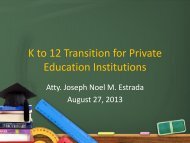
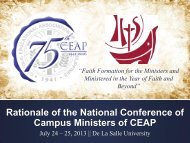
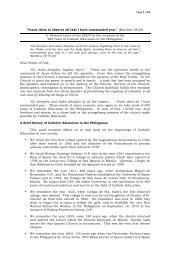
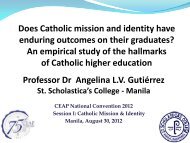

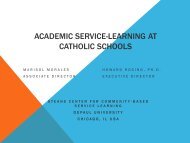

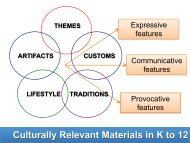
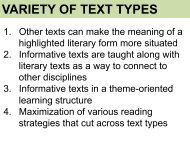
![Harmony Prayer (Silsilah Dialogue Movement) [Compatibility Mode]](https://img.yumpu.com/17302648/1/190x135/harmony-prayer-silsilah-dialogue-movement-compatibility-mode.jpg?quality=85)
